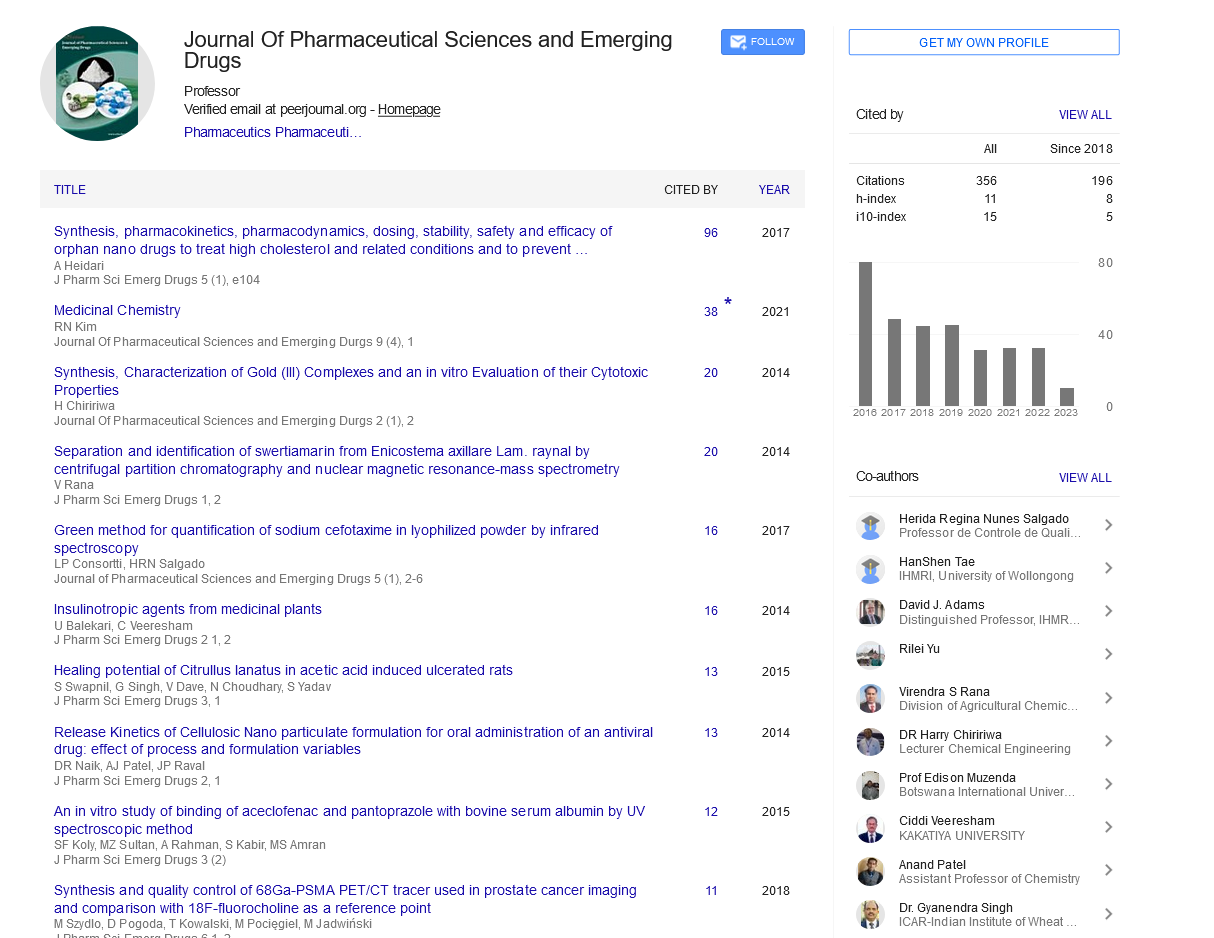Opinion Article, J Pharm Sci Emerg Drugs Vol: 12 Issue: 4
Nano carriers in Drug Transport: Revolutionizing Therapeutic Delivery
Jun Wang Zhang*
1Department of Nanotechnology, Sun Yat-sen University, Guangzhou, Guangdong 510006, China
*Corresponding Author: Jun Wang Zhang,
Department of Nanotechnology, Sun Yatsen
University, Guangzhou, Guangdong 510006, China
E-mail: jwzhang@gmail.com
Received date: 21 July, 2024, Manuscript No. JPSED-24-148307;
Editor assigned date: 23 July, 2024, PreQC No. JPSED -24-148307 (PQ);
Reviewed date: 06 August, 2024, QC No. JPSED -24-148307;
Revised date: 13 August, 2024, Manuscript No. JPSED-24-148307 (R);
Published date: 20 August, 2024, DOI: 10.4172/2380-9477.1000197.
Citation: Zhang JW (2024) Nano carriers in Drug Transport: Revolutionizing Therapeutic Delivery. J Pharm Sci Emerg Drugs 12:4.
Description
Nano carriers have emerged as a revolutionary tool in the field of drug transport and therapeutic delivery, offering significant advantages over traditional drug delivery methods. As the demand for more precise, efficient and targeted therapies grows, Nano carriers provide a solution by enhancing drug solubility, bioavailability and controlled release while minimizing side effects. This essay will explore the various types of Nano carriers, their mechanisms of action, and their potential to revolutionize therapeutic delivery. Nano carriers refer to a wide variety of nanoscale materials, typically ranging from 1 to 100 nanometers, that can encapsulate or carry therapeutic agents. Some of the most common types include liposomes, polymeric nanoparticles, micelles, dendrimers and solid lipid nanoparticles.
Liposomes are spherical vesicles with a lipid bilayer that can encapsulate hydrophilic and hydrophobic drugs. They are biocompatible and versatile, making them ideal for controlled drug release. Polymeric nanoparticles are made from biodegradable polymers like PLGA (Poly Lactic-Co-Glycolic Acid). These nanoparticles provide sustained drug release and protection from enzymatic degradation. Micelles consist of amphiphilic molecules that form core-shell structures in aqueous solutions. Their hydrophobic core can carry poorly soluble drugs, improving their bioavailability. Dendrimers are highly branched, tree-like structures that can hold multiple drug molecules and targeting ligands, offering high precision in targeting specific cells or tissues. Solid lipid nanoparticles combine the advantages of liposomes and polymeric nanoparticles, offering good biocompatibility and the ability to carry both hydrophilic and lipophilic drugs.
Nano carriers transport drugs to specific sites in the body by exploiting different delivery mechanisms. One of the key benefits of using Nano carriers is their ability to enhance drug accumulation at targeted sites, such as cancerous tissues, through passive or active targeting. Passive targeting relies on the enhanced permeability and retention (EPR) effect, which occurs when Nano carriers accumulate in tumor tissues due to leaky blood vessels and poor lymphatic drainage. This allows the Nano carriers to deliver higher concentrations of drugs directly to the tumor, minimizing systemic exposure and reducing side effects.
Active targeting involves modifying the surface of Nano carriers with ligands, antibodies, or peptides that can specifically bind to receptors on the surface of target cells. This allows for precise delivery of drugs to the desired tissues or cells, improving the efficacy of the treatment while minimizing damage to healthy tissues. Nano carriers offer several key advantages over conventional drug delivery methods. First, they enhance the solubility of poorly water-soluble drugs, increasing their bioavailability and therapeutic effect. Second, they protect drugs from enzymatic degradation in the body, allowing for longer circulation times and more sustained drug release. Third, they allow for targeted delivery, reducing systemic toxicity and improving patient outcomes.
However, the application of Nano carriers is not without challenges. One of the major obstacles is the body’s immune response, which can recognize and eliminate Nano carriers before they reach their target. Additionally, the large-scale production of Nano carriers that meet clinical standards is still a complex and costly process. The safety and long-term effects of Nano carriers also require further study to ensure they do not cause unforeseen adverse reactions in patients. In conclusion, Nano carriers represent a revolutionary advancement in the field of drug transport and therapeutic delivery. By improving drug solubility, targeting specific tissues and offering controlled release, Nano carriers hold great potential for improving treatment outcomes and reducing side effects. While challenges remain in their development and clinical application, ongoing research and technological advancements continue to push the boundaries of what is possible in drug delivery systems.
 Spanish
Spanish  Chinese
Chinese  Russian
Russian  German
German  French
French  Japanese
Japanese  Portuguese
Portuguese  Hindi
Hindi 